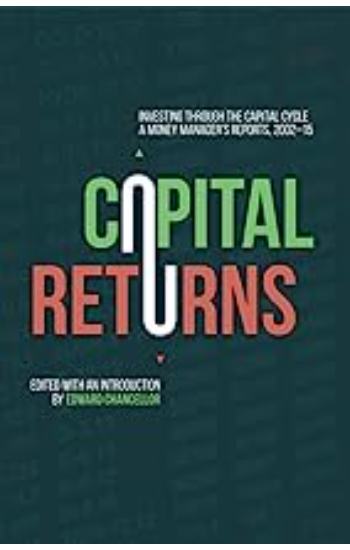
Save: 0%

Save: 10%
Capital Returns
Publisher:
| Author:
| Language:
| Format:
Publisher:
Author:
Language:
Format:
₹899 ₹674
Save: 25%
In stock
Ships within:
In stock
| Book Type |
|---|
ISBN:
Page Extent:
This book provides expert, example-driven guidance on the crash-beating capital cycle approach to investing, successfully deployed by Marathon Asset Management over the past two decades.
We live in an age of serial asset bubbles and spectacular busts. Economists, policymakers, central bankers and most people in the financial world have been blindsided by these busts, while investors have lost trillions. Economists argue that bubbles can only be spotted after they burst and that market moves are unpredictable. Yet Marathon Asset Management, a London-based investment firm managing over $50 billion of assets has developed a relatively simple method for identifying and potentially avoiding them: follow the money, or rather the trail of investment. Bubbles whether they affect a whole economy or merely a single industry, tend to attract a splurge of capital spending. Excessive investment drives down returns and leads inexorably to a bust.
This was the case with both the technology bubble at the turn of the century and the US housing bubble which followed shortly after. More recently, vast sums have been invested in mining and energy. From an investor’s perspective, the trick is to avoid investing in sectors, or markets, where investment spending is unduly elevated and competition is fierce, and to put one’s money to work where capital expenditure is depressed, competitive conditions are more favourable and, as a result, prospective investment returns are higher. This capital cycle strategy encourages investors to eschew the simple ‘growth’ and ‘value’ dichotomy and identify firms that can deliver superior returns either because capital has been taken out of an industry, or because the business has strong barriers to entry (what Warren Buffett refers to as a ‘moat’). Some of Marathon’s most successful investments have come from obscure, sometimes niche operations whose businesses are protected from the destructive forces of the capital cycle. Capital Returns is a comprehensive introduction to the theory and practical implementation of the capital cycle approach to investment. Edited and with an introduction by Edward Chancellor, the book brings together 60 of the most insightful reports written between 2002 and 2014 by Marathon portfolio managers.
Capital Returns provides key insights into the capital cycle strategy, all supported with real life examples from global brewers to the semiconductor industry – showing how this approach can be usefully applied to different industry conditions and how, prior to 2008, it helped protect assets from financial catastrophe. This book will be a welcome reference for serious investors who looking to maximise portfolio returns over the long run.
This book provides expert, example-driven guidance on the crash-beating capital cycle approach to investing, successfully deployed by Marathon Asset Management over the past two decades.
We live in an age of serial asset bubbles and spectacular busts. Economists, policymakers, central bankers and most people in the financial world have been blindsided by these busts, while investors have lost trillions. Economists argue that bubbles can only be spotted after they burst and that market moves are unpredictable. Yet Marathon Asset Management, a London-based investment firm managing over $50 billion of assets has developed a relatively simple method for identifying and potentially avoiding them: follow the money, or rather the trail of investment. Bubbles whether they affect a whole economy or merely a single industry, tend to attract a splurge of capital spending. Excessive investment drives down returns and leads inexorably to a bust.
This was the case with both the technology bubble at the turn of the century and the US housing bubble which followed shortly after. More recently, vast sums have been invested in mining and energy. From an investor’s perspective, the trick is to avoid investing in sectors, or markets, where investment spending is unduly elevated and competition is fierce, and to put one’s money to work where capital expenditure is depressed, competitive conditions are more favourable and, as a result, prospective investment returns are higher. This capital cycle strategy encourages investors to eschew the simple ‘growth’ and ‘value’ dichotomy and identify firms that can deliver superior returns either because capital has been taken out of an industry, or because the business has strong barriers to entry (what Warren Buffett refers to as a ‘moat’). Some of Marathon’s most successful investments have come from obscure, sometimes niche operations whose businesses are protected from the destructive forces of the capital cycle. Capital Returns is a comprehensive introduction to the theory and practical implementation of the capital cycle approach to investment. Edited and with an introduction by Edward Chancellor, the book brings together 60 of the most insightful reports written between 2002 and 2014 by Marathon portfolio managers.
Capital Returns provides key insights into the capital cycle strategy, all supported with real life examples from global brewers to the semiconductor industry – showing how this approach can be usefully applied to different industry conditions and how, prior to 2008, it helped protect assets from financial catastrophe. This book will be a welcome reference for serious investors who looking to maximise portfolio returns over the long run.


